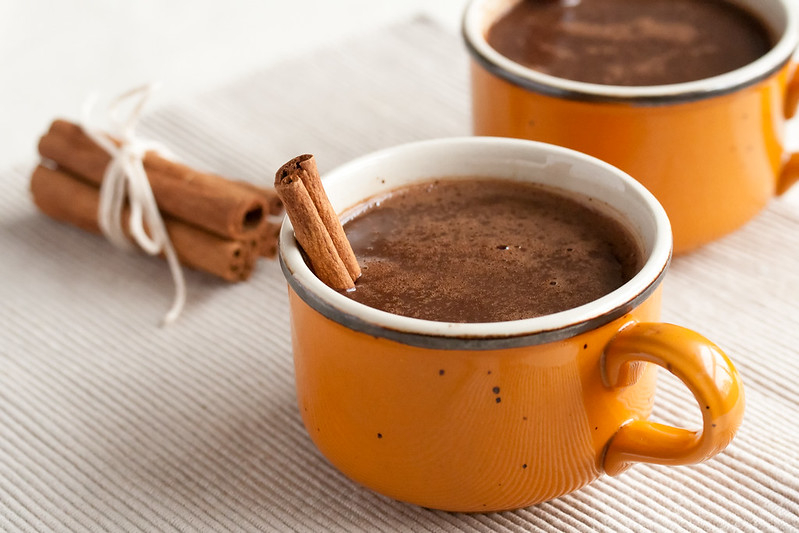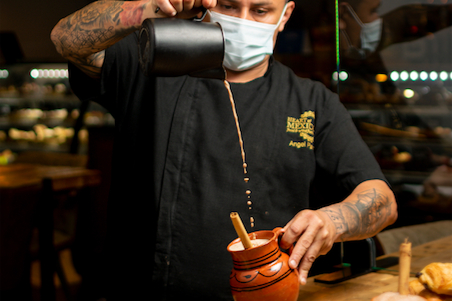
Hot, sweet, and fragrant with cinnamon and spices, Mexican hot chocolate is a delicious beverage that’s equally great by itself or when served with pastries like churros or sweet bread. In Mexico, chocolate has been an important part of the country’s culinary history for thousands of years, although the traditional beverage was quite different in taste than the current version. In modern times, this Mexican style of hot chocolate has also migrated to the United States courtesy of Mexican immigrants. On a chilly evening, there’s perhaps nothing better than a warm cup of Mexican hot chocolate.
What Makes Mexican Hot Chocolate Unique?
Historically, cacao beans were fermented and roasted before being made into a beverage (corn and chili peppers were frequently added). This ancient chocolate beverage was unsweetened and used primarily for religious rituals or medicinal purposes. By modern tastes, this historical chocolate beverage might taste strange to those used to sweetened chocolate. It wasn’t until the Spanish encountered chocolate that the beverage started its evolution to its current sweetened iteration. At first, the Spanish did not like chocolate, finding the taste to be unsuitable to their palate. Eventually, these Spanish conquistadors brought chocolate back to Europe. Over time, the ingredients morphed with the addition of sugar, changing it to the sweetened beverage commonly enjoyed today.
Unlike American hot chocolate, Mexican hot chocolate is alive with spices. In contemporary Mexican culture, hot chocolate is a frothy, sweet drink flavored with sugar, cinnamon, and sometimes vanilla. While it’s consumed throughout the year, the drink is especially popular for holiday celebrations like Christmas, Three Kings Day, and Día de Los Muertos (Day of the Dead). On these holidays, like the Day of the Dead, it’s common to have pastries like pan de Muertos (a Mexican sweet bread) with your hot chocolate.
An important element of Mexican hot chocolate is its frothy texture. The key to achieving this is through the use of a molinillo. This wooden whisk is a native Mexican creation and is the traditional tool used to create the unique frothy texture indicative of Mexican hot chocolate. There’s also a distinctive whisking technique. The process starts with taking the molinillo in both hands and placing it into a jarro (a jug that contains the beverage ingredients). Then, pressing both palms together, the molinillo is twisted back and forth to create a froth in the beverage.
Mexican Hot Chocolate

By Chef Luis Parra of Hilton Playa del Carmen, Mexico.
This recipe is from Hilton Playa del Carmen, an all-inclusive, adults-only resort in Mexico. Located in the Riviera Maya region, and just steps away from the vibrant Fifth Avenue of Playa del Carmen, this beachfront resort features sweeping ocean views, palm-lined, and white-sand beaches.
Although this hot chocolate recipe is fabulous by itself, the addition of pastries like churros or pan de Muertos is always a welcome accompaniment. For an adult twist, Chef Parra suggests adding a shot of your favorite tequila for a kick.
Ingredients:
- 1.5 cups Mexican melting chocolate
- 3 tbsp of honey
- 4 cups milk (soy, almond, oat, etc.)
- 1 cinnamon stick or pinch of cinnamon
- 1.5 oz tequila (optional)
Method:
- Roughly chop or grate Mexican chocolate and set aside.
- Over low heat, bring four cups of milk in a small saucepan to a gentle boil.
- Mix in the chocolate and honey stirring frequently with a molinillo, globe beater, or whisk until dissolved and foam is generated.
- Remove from heat. While chocolate is hot and frothy, sprinkle with cinnamon and serve with pan de muerto.
- Optional: Add 1.5 ounces of your favorite tequila for a delicious, spiked version.
Editors' Recommendations
- How to make a killer meatloaf (and it’s easier than you think)
- How to make the best vodka gimlet for a twist on a classic
- How to make the perfect carnitas, according to a chef
- How to make a buttery hollandaise sauce like a professional chef
- How to make sweet and crispy Hawaiian fried chicken




